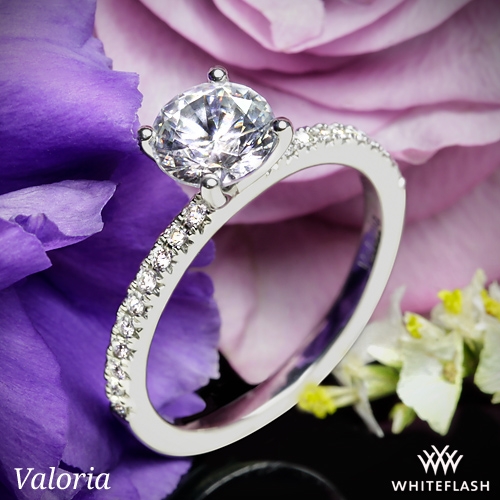
The Ultimate $5,000 Diamond Ring Buying Guide
May 18, 2023Flawless VS Internally Flawless Diamonds
September 6, 2023Best Diamond Engagement Rings Under $2500: A Comprehensive Guide

An engagement ring is more than just a piece of jewelry; it’s a symbol of love, commitment, and the beginning of a lifelong journey together. For many, the thought of finding the perfect ring is accompanied by the daunting idea of its cost. There’s a prevailing myth that a beautiful engagement ring will inevitably break the bank. However, the truth is far more encouraging. With the right insights and a touch of patience, it’s entirely possible to discover a ring that’s both stunning and affordable. This guide is here to debunk the myth and show you how to find that dream engagement ring, even on a budget of $2500 or less. Let’s embark on this sparkling journey together!
Summary:
- Setting Your Priorities
- Understanding the 4Cs within the Budget
- Choosing the Right Setting
- Metal Choices on a Budget
- Top Picks: Diamond Engagement Rings Under $2500
- Tips for Maximizing Your Budget
- FAQs
Setting Your Priorities
Before diving into the world of diamonds and engagement rings, it’s crucial to establish what’s most important to you and your partner. Setting clear priorities will not only streamline your search but also ensure that you get the best value for your budget. Here are some key considerations to keep in mind:
- Style and Design: Does your partner prefer a classic solitaire, a vintage-inspired setting, or perhaps a modern halo design? Understanding their style preference can help narrow down choices and focus on what truly matters.
- Diamond Quality: While everyone loves a flawless diamond, it’s essential to remember that many imperfections are microscopic and won’t be visible to the naked eye. Here are some tips to consider:
- Clarity: Instead of aiming for the highest clarity grades like VVS or IF, look for diamonds that are “eye-clean” in the VS2-SI1 range. These diamonds typically have inclusions that are not visible without magnification, offering excellent value for money.
- Lab-Grown Diamonds: If you’re open to non-traditional options, consider lab-grown diamonds. They are identical to natural diamonds in appearance and properties but often come at a reduced cost.
- Metal Type: The choice of metal can influence the ring’s overall cost. While platinum is durable and hypoallergenic, 14k gold can be a more budget-friendly option that still offers a luxurious look.
- Alternative Gemstones: If you’re open to straying from tradition, consider alternative gemstones like sapphires, rubies, or moissanites. These stones can be equally captivating and often come at a fraction of the cost of a diamond.
- Customization: While custom designs can be a way to infuse personal touches, they might also come with a higher price tag. Consider pre-designed settings that align with your partner’s taste and remember that the sentiment behind the ring is what truly counts.
By understanding what’s non-negotiable and where you can be flexible, you’ll be better equipped to find an engagement ring that resonates with your partner’s taste while staying within your budget.
Understanding the 4Cs within the Budget
The 4Cs—Carat, Cut, Color, and Clarity—are the universal language of diamond quality. By understanding how each of these factors impacts a diamond’s appearance and price, you can make informed decisions that align with your budget. Let’s delve into each of these aspects:
- Carat: This refers to the weight and size of the diamond. While a larger carat size can be more expensive, remember that the visual difference between close carat weights (like 0.9 and 1.0) can be minimal but can result in significant cost savings.
- Cut: Often considered the most critical factor, the cut determines how well a diamond reflects light, influencing its brilliance and sparkle. Prioritize a high-quality cut within your budget, as it can make a diamond appear larger and mask color and clarity imperfections.
- Color: Diamonds are graded on a scale from D (colorless) to Z (light yellow or brown). For the best value, consider diamonds in the G to I range, which appear near-colorless to most observers but are priced lower than D-F diamonds.
- Clarity: Clarity grades assess the number, size, and position of inclusions and blemishes in a diamond. As mentioned earlier, aim for “eye-clean” diamonds in the VS2-SI1 range. They offer excellent value as their inclusions are typically invisible without magnification.
- Certification: When investing in a diamond, always ensure it comes with a certification from an internationally recognized lab. For natural diamonds, the Gemological Institute of America (GIA) is the gold standard. For lab-grown diamonds, the International Gemological Institute (IGI) is highly reputable. These certifications provide an unbiased assessment of the diamond’s quality and ensure you’re getting what you pay for.
By balancing the 4Cs with your budget and prioritizing what’s most important to you, you can find a diamond that offers the best value and beauty. Remember, while the 4Cs provide a framework, the ultimate goal is to find a diamond that you and your partner will cherish forever.
Choosing the Right Setting
The setting of an engagement ring not only enhances the diamond’s beauty but also reflects the wearer’s personal style. While the diamond may be the star of the show, the setting plays a crucial role in determining the ring’s overall look and feel. Here are some tips to help you choose the perfect setting within your budget:
- Understand the Basics: There are numerous settings available, from classic solitaires and vintage-inspired designs to modern halos and intricate pave settings. Familiarize yourself with the most popular types to determine which resonates with your partner’s style.
- Consider Maintenance: Intricate designs with many small diamonds, like a pave or halo setting, might require more frequent maintenance than simpler designs. If low maintenance is a priority, opt for settings like solitaire or three-stone.
- Factor in the Diamond Size: Some settings, like the halo, can make a center diamond appear larger. If you’re working with a smaller carat weight, such settings can maximize its visual impact.
- Metal Matters: The metal you choose—be it white gold, yellow gold, platinum, or rose gold—can influence the ring’s overall appearance and price. While platinum is durable and pure, it’s also more expensive. White gold, on the other hand, offers a similar look for a lower price but may require occasional re-plating.
- Personalize: Many jewelers offer customization options. Adding personal touches, like a birthstone on the ring’s interior or an engraving, can make the ring even more special without significantly impacting the cost.
Remember, the setting should complement both the diamond and the wearer’s style. It’s a reflection of your partner’s personality and the unique love story you share. Take your time exploring options and consider consulting with jewelers to find a setting that’s both beautiful and budget-friendly.
Metal Choices on a Budget
The choice of metal for your engagement ring can significantly influence both its appearance and cost. Each metal has its unique properties, aesthetics, and price points. Here’s a guide to help you navigate your choices without breaking the bank:
- White Gold: A popular choice for many, white gold offers the sleek, modern appearance of platinum but at a more budget-friendly price. It’s an alloy of gold mixed with other metals, giving it its signature silver color. However, it may require occasional rhodium plating to maintain its luster and prevent tarnishing.
- Yellow Gold: Timeless and classic, yellow gold is a pure form of gold mixed with alloy metals like copper and zinc. It’s naturally more malleable, making it a good choice for intricate designs. The higher the karat (14k, 18k), the purer the gold, but also the softer it is. For everyday wear, 14k is often recommended as it offers a good balance of purity and strength.
- Rose Gold: This romantic metal has gained popularity in recent years. Its pinkish hue comes from a combination of gold and copper. Rose gold is durable and doesn’t require rhodium plating. Its unique color also offers a contemporary twist on traditional ring designs.
- Platinum: While platinum is the most durable and purest metal, it’s also the most expensive. If you’re set on platinum but are working with a tight budget, consider opting for a simpler ring design or a smaller diamond to offset the cost.
- Sterling Silver: Less commonly used for engagement rings, sterling silver is an affordable option. However, it’s softer than other metals and might tarnish over time, requiring more maintenance.
Always remember to consider your partner’s lifestyle and preferences. Some metals are more scratch-resistant than others, making them more suitable for those with active lifestyles. Additionally, ensure that the chosen metal complements the diamond or gemstone’s color and the ring’s overall design.
Top Picks: Diamond Engagement Rings Under $2500
We have multiple options to consider; we can focus on the diamond, concentrate on the setting, or even explore the possibility of purchasing a lab diamond to get the best of both worlds.
If we’re looking to focus on the diamond I would suggest this 0.70 ct I SI1 A CUT ABOVE® Hearts and Arrows Diamond from Whiteflash.
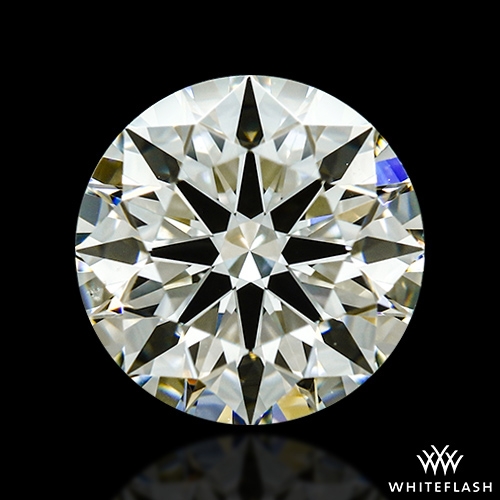
This is the perfect balance of size and cut quality coming in at $2,027. This could be perfectly combined with this 14k White Gold Valoria Petite Six Prong Solitaire Engagement Ring ($481) bringing our total to $2,508.

Or we focus on the setting and get something like this 14K White Gold Falling Edge Pavé Diamond Engagement Ring from James Allen ($2,090).
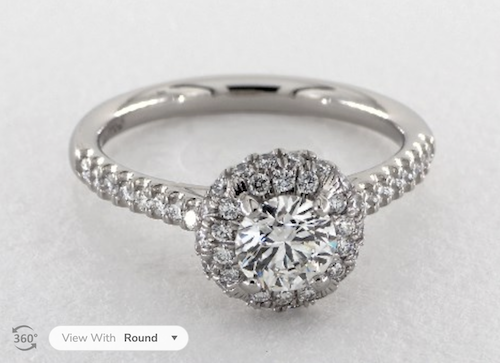
Combine with this J SI2 0.50 Carat Round Diamond ($500) bringing the total to $2,590.
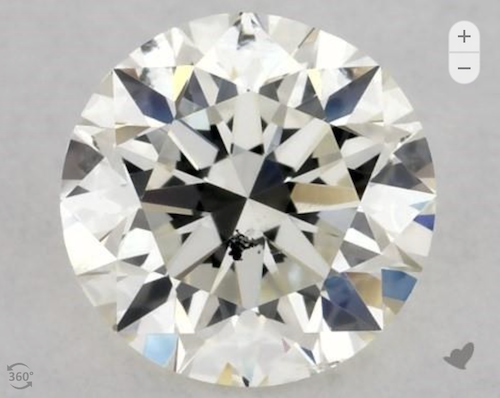
Lastly we could aim for the best of both worlds. Combining this 1.13 ct E VVS2 Round Cut Precision Lab Grown Diamond from Whiteflash ($1,543)
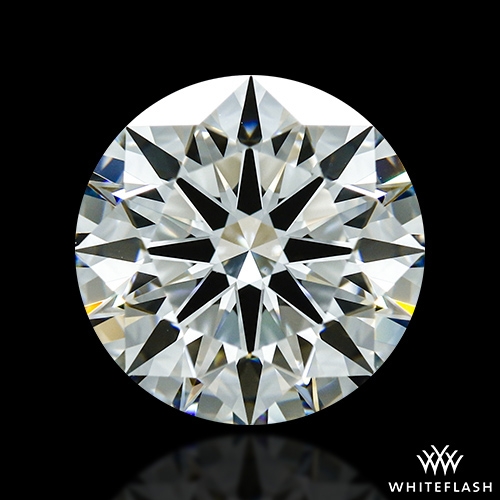
With this 14k White Gold Valoria Petite Pave Diamond Engagement Ring ($966) bringing our total to $2,509.
Tips for Maximizing Your Budget
When it comes to purchasing an engagement ring, you want the best value without compromising on quality. Here are some savvy strategies to get the most sparkle for your buck:
- Opt for Eye-Clean Diamonds: Instead of going for the highest clarity grades like VVS or IF, consider diamonds in the VS or SI range that are “eye-clean.” This means that while they might have inclusions, these imperfections aren’t visible to the naked eye. You get a beautiful diamond at a fraction of the price.
- Consider Near-Colorless Diamonds: Diamonds in the I to K color range can offer excellent value. To an untrained eye, they appear just as colorless as those in the D to F range but come at a much lower cost.
- Choose a Lab-Grown Diamond: Lab-grown diamonds are virtually identical to natural diamonds in terms of physical, chemical, and optical properties. They can be 70-80% less expensive than their mined counterparts, allowing you to either save money or allocate more of your budget to a larger stone or a more intricate setting.
- Go Just Below Popular Carat Weights: Instead of a full 1.0 or 1.5 carat diamond, consider sizes like 0.9 or 1.4 carats. The size difference is hardly noticeable, but the price difference can be significant. For a $2,500 budget I’d suggest aiming between 0.45 to 0.89.
- Experiment with Diamond Shapes: Round diamonds are the most popular and tend to be the most expensive. Exploring other shapes, like oval, cushion, or princess, can give you more bang for your buck.
- Prioritize Cut Quality: Of all the 4Cs, cut has the most impact on a diamond’s brilliance. A well-cut diamond can appear larger and more brilliant than its carat weight might suggest. Prioritizing cut can ensure you get a diamond that sparkles brilliantly, regardless of its size.
Remember, the engagement ring is a symbol of your love and commitment. It’s not about how much you spend, but the thought and care you put into choosing the perfect ring for your partner.
Choosing an engagement ring is a significant decision, both emotionally and financially. While the journey might seem daunting, especially when working with a budget, it’s entirely possible to find a beautiful ring that doesn’t break the bank. By understanding the intricacies of diamonds, prioritizing what matters most to you and your partner, and employing smart shopping strategies, you can secure a ring that’s both stunning and affordable. Remember, it’s the sentiment behind the ring that truly counts, and with the right approach, you can make your proposal memorable without compromising on quality.


